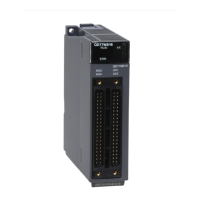7 - 26 7 - 26
MELSEC-Q
7 APPLICATION FUNCTIONS
(b) Setting example B
The routing parameters must be set for the request source 1), relay station
2), relay station 3), relay station 4), relay station 5), relay station 6), relay
station 7), and relay station 8).
In addition, there are two types of routing parameter settings; one is used
when sending data from the request source to the request destination
(when sending a request), and the other is used when returning from the
request destination to the request source (when sending a response).
Either one of them or both must be set for each station.
1N
S
3 1N
S
22M
P
1 2N
S
2 3N
S
3 3N
S
2 4M
P
1
7MP16NS2 6MP15NS2 5MP14NS2
7NS28MP1 8NS4
1) Request source 2) Relay station 3) Relay station 4) Relay station
5) Relay station6) Relay station7) Relay station
8) Relay station 9) Request destination
1) Request source
No.
Target
network No.
Relay
network No.
Relay
station No.
1 [8] [1] [2] Used when sending a request
2) Relay station 1 [8] [2] [2] Used when sending a request
3) Relay station
1 [8] [3] [2] Used when sending a request
2 [1] [2] [1] Used when sending a response
4) Relay station
1 [8] [4] [2] Used when sending a request
2 [1] [3] [3] Used when sending a response
5) Relay station
1 [8] [5] [2] Used when sending a request
2 [1] [4] [1] Used when sending a response
6) Relay station
1 [8] [6] [2] Used when sending a request
2 [1] [5] [1] Used when sending a response
7) Relay station
1 [8] [7] [2] Used when sending a request
2 [1] [6] [1] Used when sending a response
8) Relay station 1 [1] [7] [1] Used when sending a response
POINT
If a transient transmission (SEND, READ, SREAD, WRITE, SWRITE or REQ) was
terminated abnormally, the "Time" when an error was detected, "Abnormal
detection network number," and "Abnormal detection station number" can be
checked from the control data of the instruction used.
For detail on these instructions, refer to Section 7.4.5.

